Strength, Durability, and Microstructure of Foamed Concrete Prepared Using Special Soil and Slag
Abstract
:1. Introduction
2. Materials and Methods
2.1. Materials
2.2. Mixture Proportions
2.3. Foamed Concrete Sample Preparation
2.4. Test Methods
2.4.1. Fluidity and Dry Density
2.4.2. Compressive Strength
2.4.3. Water Absorption
2.4.4. Dry–Wet Cycling Test
- I.
- Firstly, the FC was put into the oven at a temperature of 60 ± 5 °C for 48 h after 28 days of maintenance.
- II.
- Then, the FC was taken out and cooled for 30 min. After the FC was cooled to room temperature, it was put into the constant temperature water tank at a temperature of 20 ± 5 °C for 24 h, and the above was used as a set of dry–wet cycles.
- III.
- Subsequently, the FC was removed from the water tank and left to stand for 1 h for compressive strength test.
- IV.
- Finally, the water stability coefficient was calculated as the ratio between compressive strength after five dry–wet cycles and the 28 days compressive strength, as shown in Equation (2).
2.4.5. Drying Shrinkage
2.4.6. Hydration Mechanism
2.4.7. SEM Analysis
3. Results and Discussions
3.1. Fluidity and Dry Density
3.1.1. Fluidity
3.1.2. Dry Density
3.2. Compressive Strength
3.3. Water Absorption
3.4. Dry–Wet Cycling Results
3.5. Drying Shrinkage
3.6. Hydration Mechanism
3.7. Pore Structure
4. Conclusions
- (1)
- When the content of SS was 25% and the content of SP was 35%, 45% and 55%, the flowability of SSFC prepared from three SS was between 160 mm and 180 mm, the dry density was between 640 kg/m3 and 704 kg/m3, the water absorption was between 34% and 49%, and the water stability coefficient was higher than 0.7, demonstrating a good durability of SSFC.
- (2)
- The density grade of general foamed concrete is 300 kg/m3–1200 kg/m3. The dry density of the SSFC prepared in this study was about 650 kg/m3. Although SSFC had a low density, the compressive strength of SSFC was between 1.54 MPa and 3.18 MPa, which sufficiently support its application as subgrade in road engineering.
- (3)
- The rapid growth period of drying shrinkage of SSFC occurred mainly in the first 10 days and gradually stabilized within one month. The drying shrinkage reached the maximum value when the SP content was 45%. The drying shrinkage values of SSFC prepared from silt were higher than those of SSFC prepared from laterite and loess. Compared with laterite, drying shrinkage of SSFC prepared with loess can be stabilized in a shorter time. SSFC prepared with loess has better resistance to drying shrinkage.
- (4)
- The average diameter of pores in SSFC increased with the increase in SP content. In addition, the higher the SP content, the larger the SSFC porosity, and with the increase in porosity, the compressive strength of SSFC decreased and the water absorption rate increased.
- (5)
- When the content of SS is 25% and the content of SP is 35%, the compressive strength, pore structure and durability of SSFC prepared by three kinds of SS meet the requirements of engineering application. At this point, SS and SP can reduce the amount of cement used in FC by 60%, thereby reducing costs by about 30% and creating huge economic benefits. In addition, the use of SP instead of cement not only facilitates the reuse of solid waste but also reduces the amount of greenhouse gases produced in cement production, resulting in environmental benefits.
Author Contributions
Funding
Institutional Review Board Statement
Informed Consent Statement
Data Availability Statement
Acknowledgments
Conflicts of Interest
Abbreviations
| FC | foamed concrete |
| SS | special soil |
| SP | slag powder |
| PC | P.O42.5 cement |
| SSFC | soil-slag foamed concrete |
| SFC | slag-based foamed concrete |
| XRD | X-ray diffraction |
| SEM | scanning electron microscopy |
References
- Amran, Y.; Farzadnia, N.; Ali, A. Properties and applications of foamed concrete. A review. Constr. Build. Mater. 2015, 101, 990–1005. [Google Scholar] [CrossRef]
- Tian, T.; Yun, Y.; Hu, Z.; Xu, Y.; Chen, Y.; Jian, S. Utilization of original phosphogypsum for the preparation of foam concrete. Constr. Build. Mater. 2016, 115, 143–152. [Google Scholar] [CrossRef]
- Cong, X.; Qiu, T.; Xu, J.; Liu, X.; Wang, L.; Wang, Y.; Chen, C.; Zhao, L.; Xing, C.; Tan, Y. Study on the effectiveness of fibre reinforcement on the engineering performance of foamed concrete. Case Stud. Constr. Mater. 2022, 16, e01015. [Google Scholar] [CrossRef]
- Zhuo, Z.; Ali, A.; Zhu, C.; Mehta, Y.; Lein, W.; DeCarlo, C.; Elshaer, M.; Kennedy, D. Evaluating the potential of using foamed concrete as the insulation layer for pavements in cold regions. Constr. Build. Mater. 2022, 341, 127903. [Google Scholar] [CrossRef]
- Kim, T.-H.; Kim, T.-H.; Kang, G.-C. Performance evaluation of road embankment constructed using lightweight soils on an unimproved soft soil layer. Eng. Geol. 2013, 160, 34–43. [Google Scholar] [CrossRef]
- She, W.; Du, Y.; Zhao, G.; Feng, P.; Zhang, Y.; Cao, X. Influence of coarse fly ash on the performance of foam concrete and its application in high-speed railway roadbeds. Constr. Build. Mater. 2018, 170, 153–166. [Google Scholar] [CrossRef]
- Wu, J.; Lv, C.; Pi, R.; Zhang, H.; Bi, Y.; Song, X.; Wang, Z. The stability and durability of silt-based foamed concrete: A new type of road engineering material. Constr. Build. Mater. 2021, 304, 124674. [Google Scholar] [CrossRef]
- Habert, G.; Lacaillerie, J.; Roussel, N. An environmental evaluation of geopolymer based concrete production: Reviewing current research trends. J. Clean. Prod. 2011, 19, 1229–1238. [Google Scholar] [CrossRef]
- Van den Heede, P.; De Belie, N. Environmental impact and life cycle assessment (LCA) of traditional and ‘green’ concretes: Literature review and theoretical calculations. Cem. Concr. Compos. 2012, 34, 431–442. [Google Scholar] [CrossRef]
- Sanjayan, J.G.; Nazari, A.; Chen, L.; Nguyen, G.H. Physical and mechanical properties of lightweight aerated geopolymer. Constr. Build. Mater. 2015, 79, 236–244. [Google Scholar] [CrossRef]
- Wang, H.; Zhang, W.; Zhang, Y.; Xu, J. A bibliometric review on stability and reinforcement of special soil subgrade based on CiteSpace. J. Traffic Transp. Eng. 2022, 9, 223–243. [Google Scholar] [CrossRef]
- Santhikala, R.; Chandramouli, K.; Pannirselvam, N. Stabilization of expansive soil using flyash based geopolymer. Mater. Today Proc. 2022, 68, 110–114. [Google Scholar] [CrossRef]
- Francisca, F.M.; Mozejko, C.A. Hydraulic and mechanical behavior of compacted silts modified by waste steel slag. Geomech. Energy Environ. 2022, 100323. [Google Scholar] [CrossRef]
- Mishra, P.; Shukla, S.; Mittal, A. Stabilization of subgrade with expansive soil using agricultural and industrial by-products: A review. Mater. Today Proc. 2022, 65, 1418–1424. [Google Scholar] [CrossRef]
- Chen, R.; Cai, G.; Dong, X.; Mi, D.; Puppala, A.J.; Duan, W. Mechanical properties and micro-mechanism of loess roadbed filling using by-product red mud as a partial alternative. Constr. Build. Mater. 2019, 216, 188–201. [Google Scholar] [CrossRef]
- Tiwari, N.; Satyam, N. Coupling effect of pond ash and polypropylene fiber on strength and durability of expansive soil subgrades: An integrated experimental and machine learning approach. J. Rock Mech. Geotech. Eng. 2021, 13, 1101–1112. [Google Scholar] [CrossRef]
- Km, K.; Bawa, S.; Kant Sharma, S. Laboratory investigation on the effect of polypropylene and nylon fiber on silt stabilized clay. Mater. Today Proc. 2022, 52, 1368–1376. [Google Scholar] [CrossRef]
- Maheepala, M.M.A.L.N.; Nasvi, M.C.M.; Robert, D.J.; Gunasekara, C.; Kurukulasuriya, L.C. A comprehensive review on geotechnical properties of alkali activated binder treated expansive soil. J. Clean. Prod. 2022, 363, 132488. [Google Scholar] [CrossRef]
- Huang, Z.; Sun, H.-Y.; Dai, Y.-M.; Hou, P.-B.; Zhou, W.-Z.; Bian, L.-L. A study on the shear strength and dry-wet cracking behaviour of waste fibre-reinforced expansive soil. Case Stud. Constr. Mater. 2022, 16, e01142. [Google Scholar] [CrossRef]
- Duan, W.; Li, G.; Wang, Z.; Wang, D.; Yu, Q.; Zhan, Y. Highly efficient production of hydrotalcite-like compounds from blast furnace slag. Appl. Clay Sci. 2022, 219, 106441. [Google Scholar] [CrossRef]
- Alzaza, A.; Ohenoja, K.; Ahmed Shaikh, F.U.; Illikainen, M. Mechanical and durability properties of C–S–H-seeded cement mortar cured at fluctuating low temperatures with granulated blast furnace slag as fine aggregates. J. Build. Eng. 2022, 57, 104879. [Google Scholar] [CrossRef]
- Duan, W.; Wang, D.; Wang, Z.; Zhan, Y.; Mu, T.; Yu, Q. A novel synergistic method on potential green and high value-added utilization of blast furnace slag. J. Clean. Prod. 2021, 329, 129804. [Google Scholar] [CrossRef]
- Ding, Z.; Quy, N.X.; Noguchi, T.; Kim, J.; Hama, Y. A study on the change in frost resistance and pore structure of concrete containing blast furnace slag under the carbonation conditions. Constr. Build. Mater. 2022, 331, 127295. [Google Scholar] [CrossRef]
- Zbay, E.; Erdemir, M.; Durmu, H.B. Utilization and efficiency of ground granulated blast furnace slag on concrete properties—A review. Constr. Build. Mater. 2016, 105, 423–434. [Google Scholar] [CrossRef]
- Zhang, Y.; Schlangen, E.; Çopuroğlu, O. Effect of slags of different origins and the role of sulfur in slag on the hydration characteristics of cement-slag systems. Constr. Build. Mater. 2022, 316, 125266. [Google Scholar] [CrossRef]
- Seo, J.; Kim, S.; Park, S.; Yoon, H.N.; Lee, H.K. Carbonation of calcium sulfoaluminate cement blended with blast furnace slag. Cem. Concr. Compos. 2021, 118, 103918. [Google Scholar] [CrossRef]
- Wang, D.; Gao, X.; Liu, X.; Zeng, G. Strength, durability and microstructure of granulated blast furnace slag-modified magnesium oxychloride cement solidified waste sludge. J. Clean. Prod. 2021, 292, 126072. [Google Scholar] [CrossRef]
- Fu, Q.; Bu, M.; Zhang, Z.; Xu, W.; Yuan, Q.; Niu, D. Hydration Characteristics and Microstructure of Alkali-Activated Slag Concrete: A Review. Engineering 2021, in press. [Google Scholar] [CrossRef]
- Chen, P.; Shi, Z.; Cao, S.; Liu, P.; Rong, X.; Wang, L. Mechanical properties of alkali-activated slag lightweight aggregate concrete. J. Clean. Prod. 2022, 359, 132136. [Google Scholar] [CrossRef]
- Ou, Z.; Feng, R.; Li, F.; Liu, G.; Li, N. Development of drying shrinkage model for alkali-activated slag concrete. Constr. Build. Mater. 2022, 323, 126556. [Google Scholar] [CrossRef]
- Cui, P.; Wu, S.; Xiao, Y.; Hu, R.; Yang, T. Environmental performance and functional analysis of chip seals with recycled basic oxygen furnace slag as aggregate. J. Hazard. Mater. 2021, 405, 124441. [Google Scholar] [CrossRef]
- Yang, C.; Wu, S.; Cui, P.; Amirkhanian, S.; Zhao, Z.; Wang, F.; Zhang, L.; Wei, M.; Zhou, X.; Xie, J. Performance characterization and enhancement mechanism of recycled asphalt mixtures involving high RAP content and steel slag. J. Clean. Prod. 2022, 336, 130484. [Google Scholar] [CrossRef]
- Zhang, S.; Qi, X.; Guo, S.; Zhang, L.; Ren, J. A systematic research on foamed concrete: The effects of foam content, fly ash, slag, silica fume and water-to-binder ratio. Constr. Build. Mater. 2022, 339, 127683. [Google Scholar] [CrossRef]
- He, J.; Gao, Q.; Song, X.; Bu, X.; He, J. Effect of foaming agent on physical and mechanical properties of alkali-activated slag foamed concrete. Constr. Build. Mater. 2019, 226, 280–287. [Google Scholar] [CrossRef]
- Mastali, M.; Kinnunen, P.; Isomoisio, H.; Karhu, M.; Illikainen, M. Mechanical and acoustic properties of fiber-reinforced alkali-activated slag foam concretes containing lightweight structural aggregates. Constr. Build. Mater. 2018, 187, 371–381. [Google Scholar] [CrossRef]
- Oren, O.H.; Gholampour, A.; Gencel, O.; Ozbakkaloglu, T. Physical and mechanical properties of foam concretes containing granulated blast furnace slag as fine aggregate. Constr. Build. Mater. 2020, 238, 117774. [Google Scholar] [CrossRef]
- Hao, Y.; Yang, G.; Liang, K. Development of fly ash and slag based high-strength alkali-activated foam concrete. Cem. Concr. Compos. 2022, 128, 104447. [Google Scholar] [CrossRef]
- Liu, Y.; Zhang, Z.; Hou, G.; Yan, P. Preparation of sustainable and green cement-based composite binders with high-volume steel slag powder and ultrafine blast furnace slag powder. J. Clean. Prod. 2021, 289, 125133. [Google Scholar] [CrossRef]
- Peng, Y.; Ou, X.; Chen, X.; Lin, X.; Shen, X. Utilization of discarded bauxite tailings into eco-friendly foamed mixture lightweight soil. J. Clean. Prod. 2022, 333, 130167. [Google Scholar] [CrossRef]
- Xie, Y.; Li, J.; Lu, Z.; Jiang, J.; Niu, Y. Effects of bentonite slurry on air-void structure and properties of foamed concrete. Constr. Build. Mater. 2018, 179, 207–219. [Google Scholar] [CrossRef]


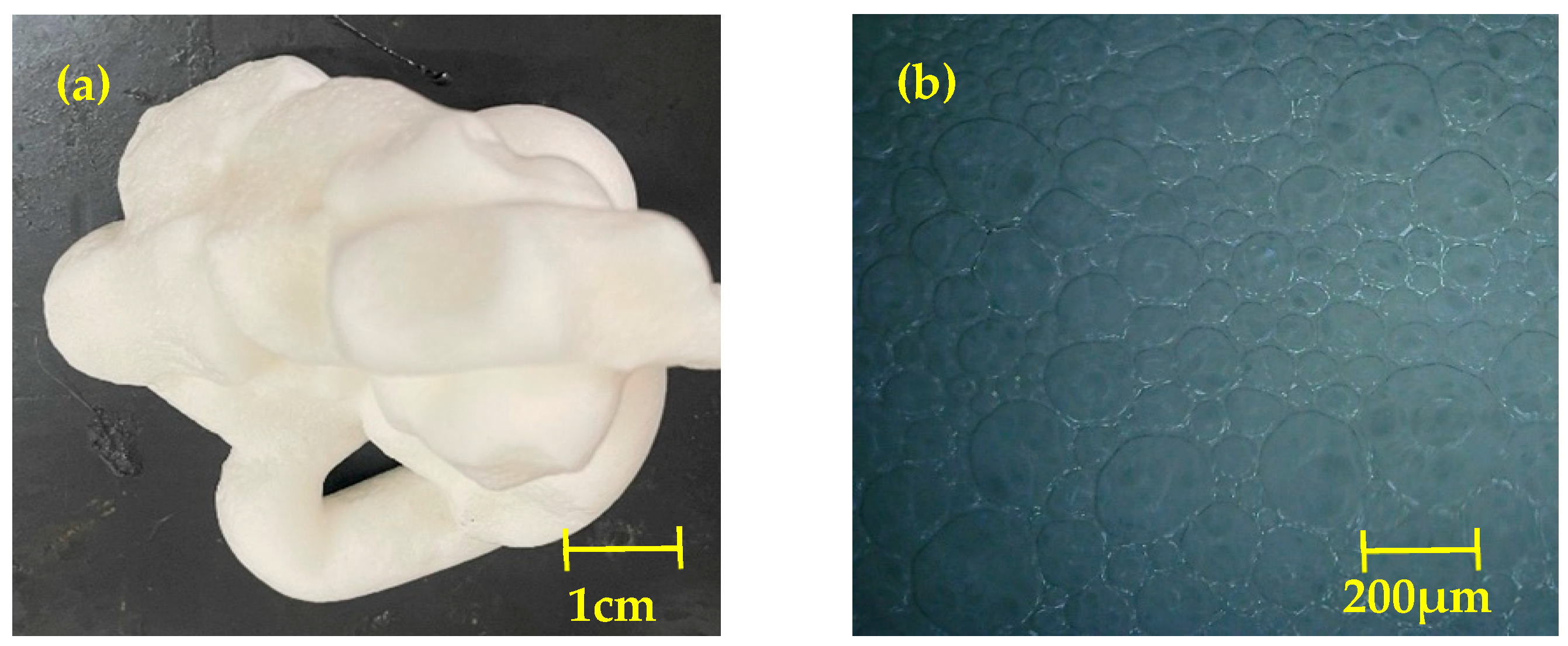



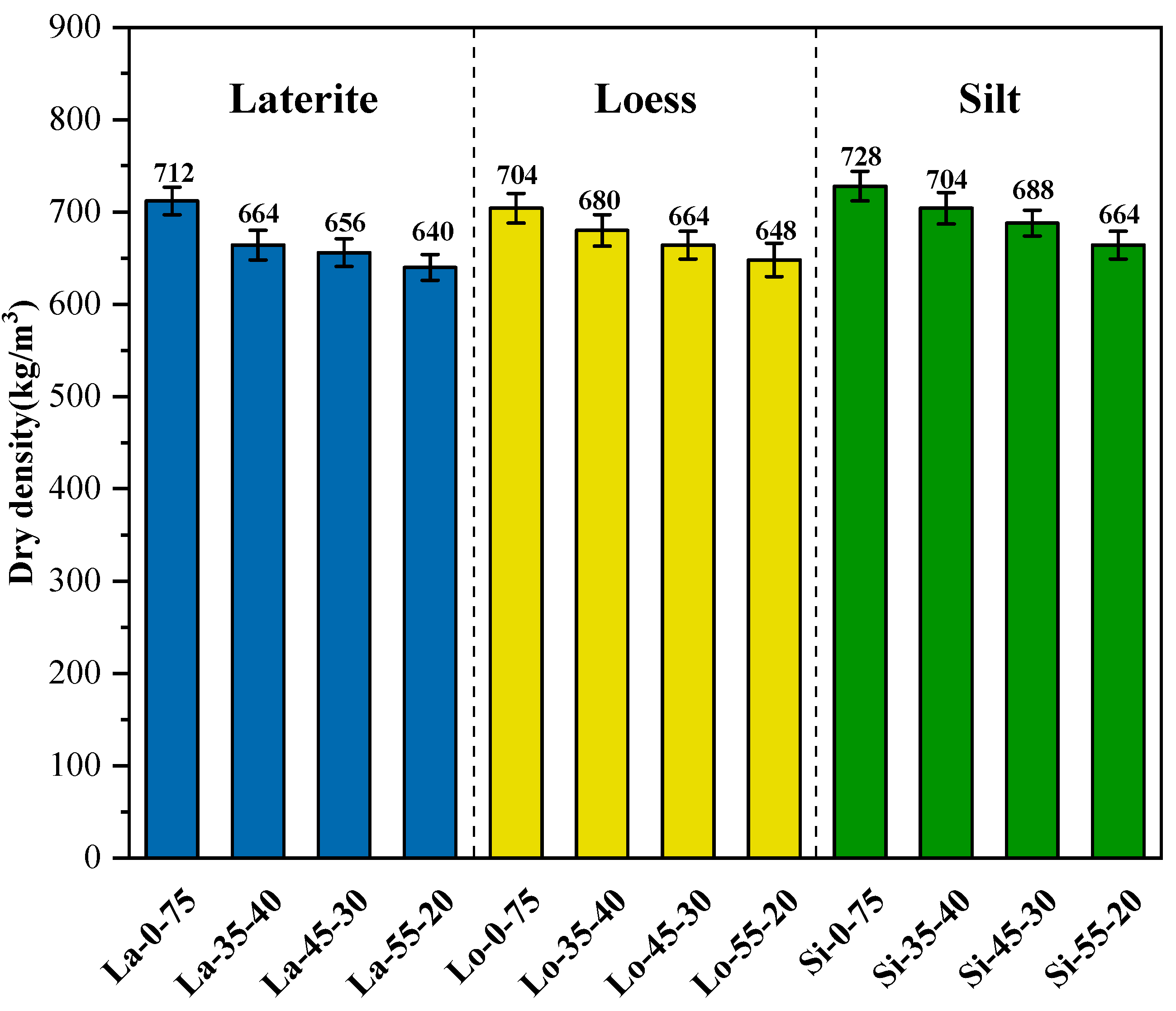
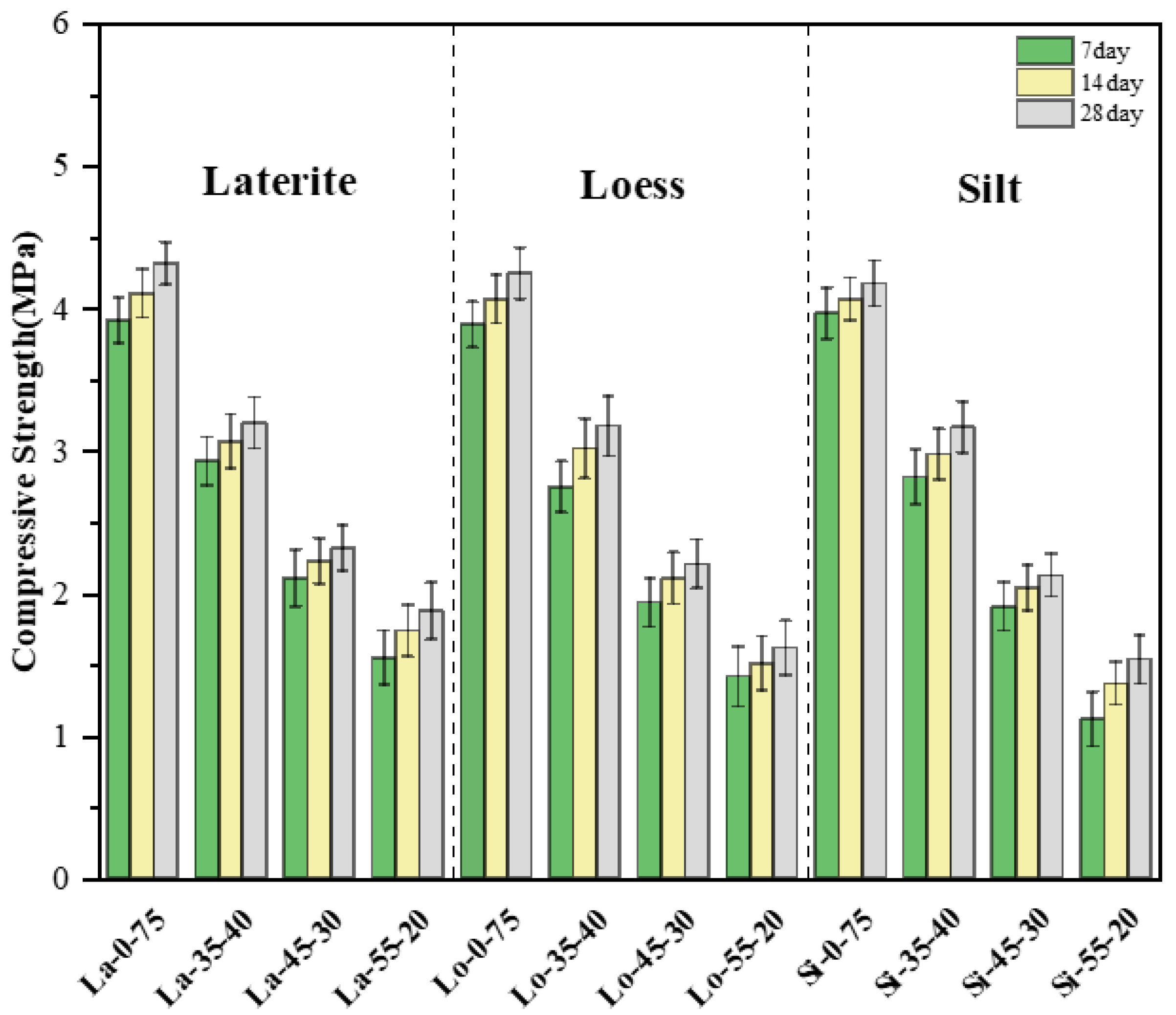

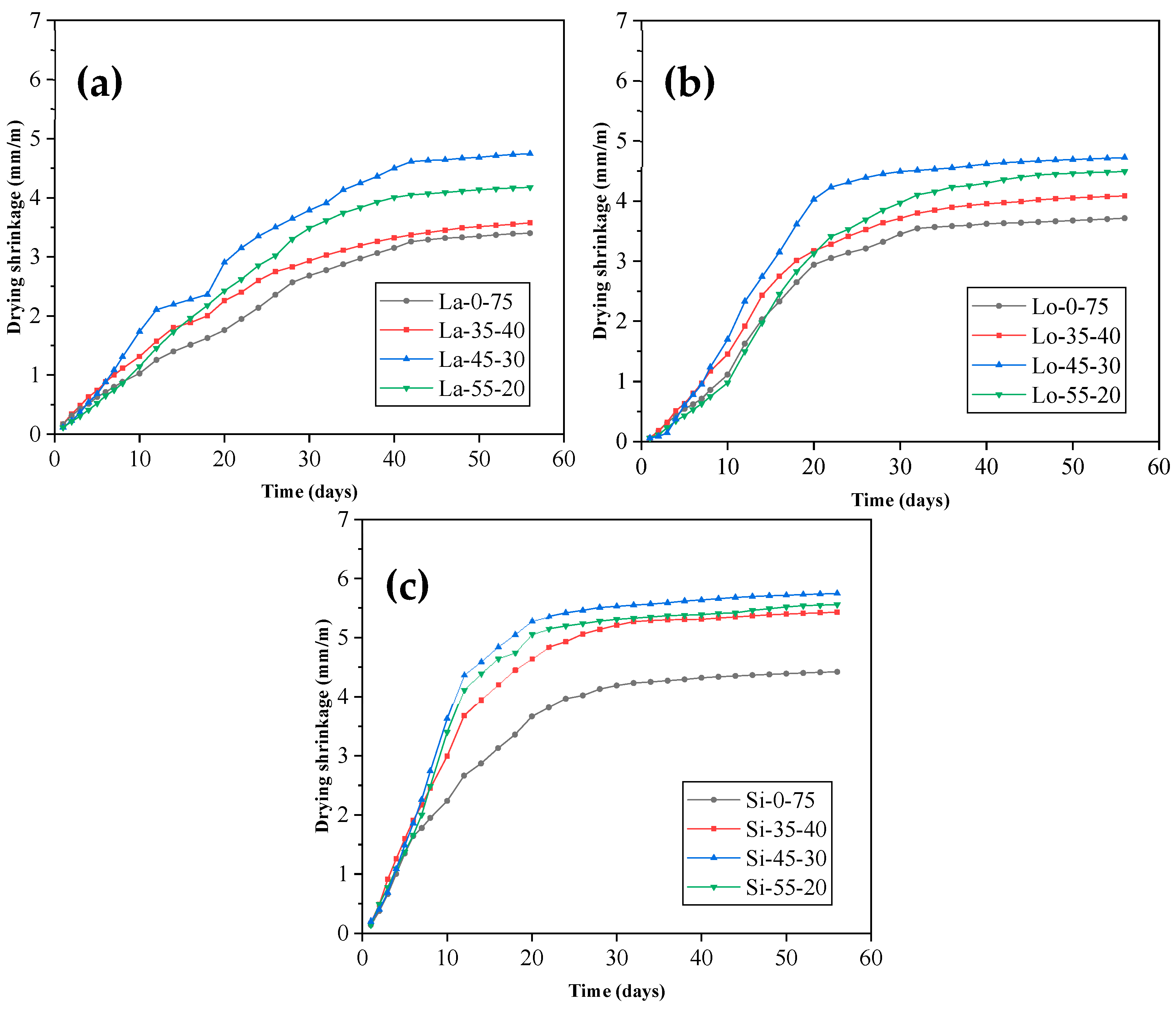
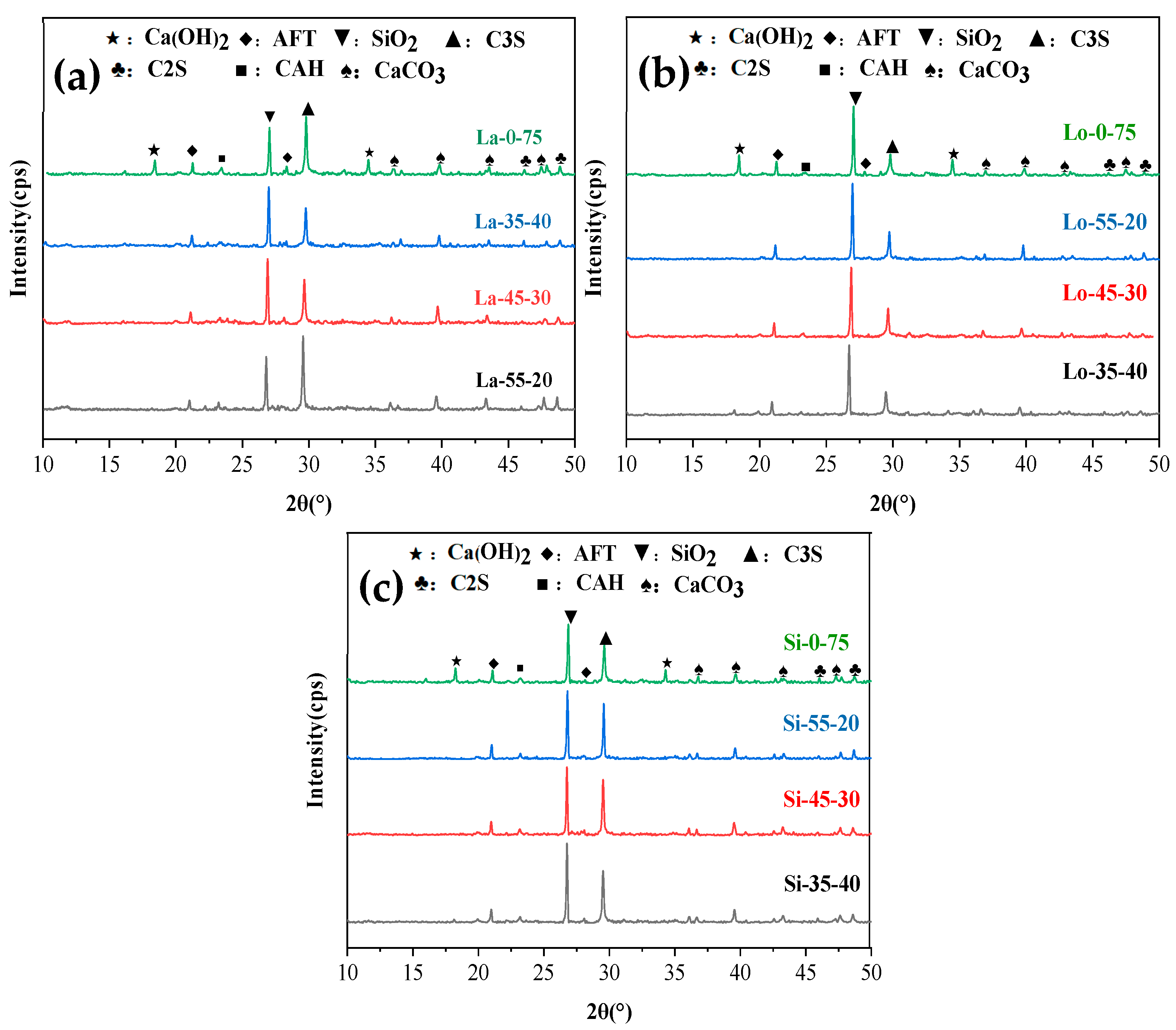
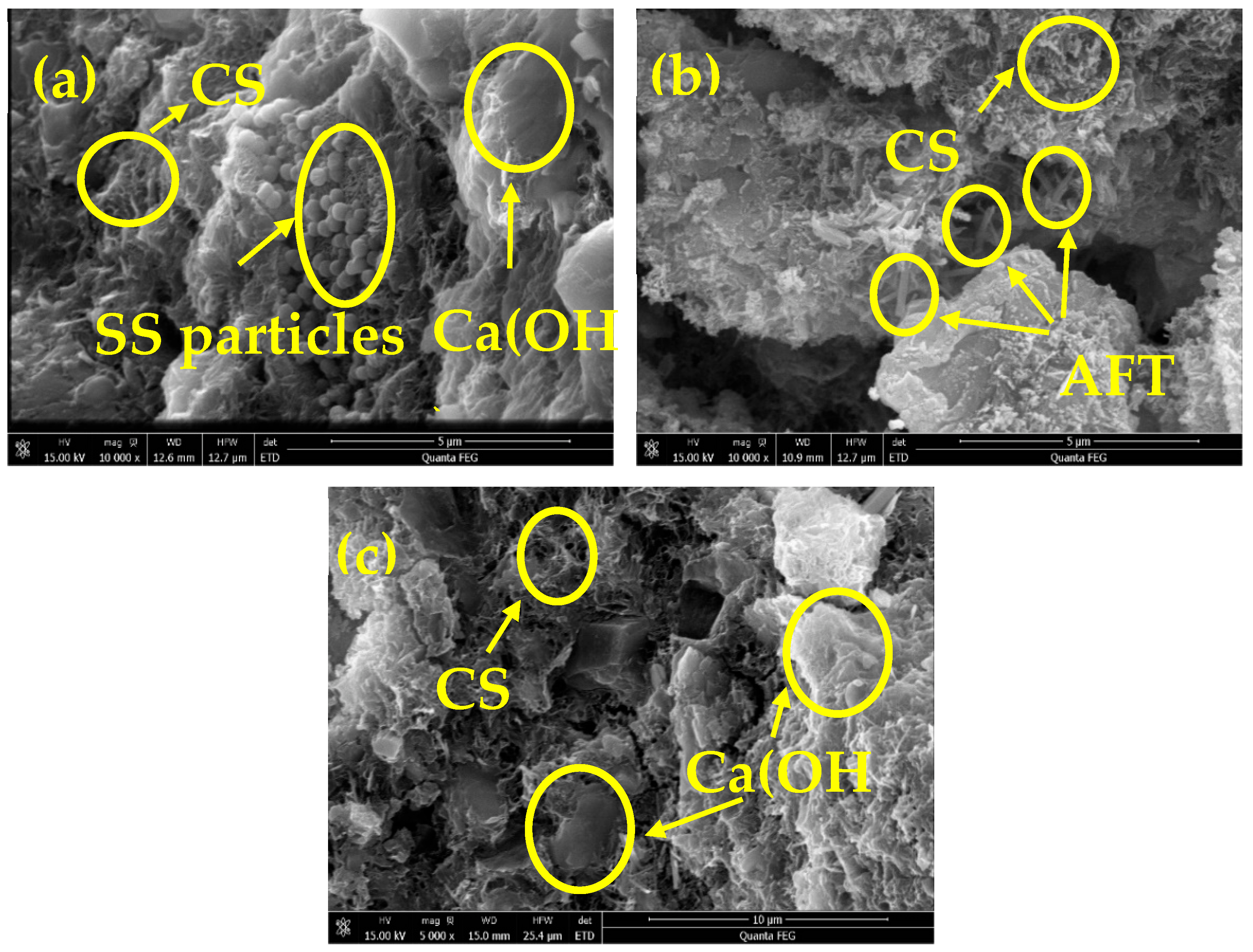
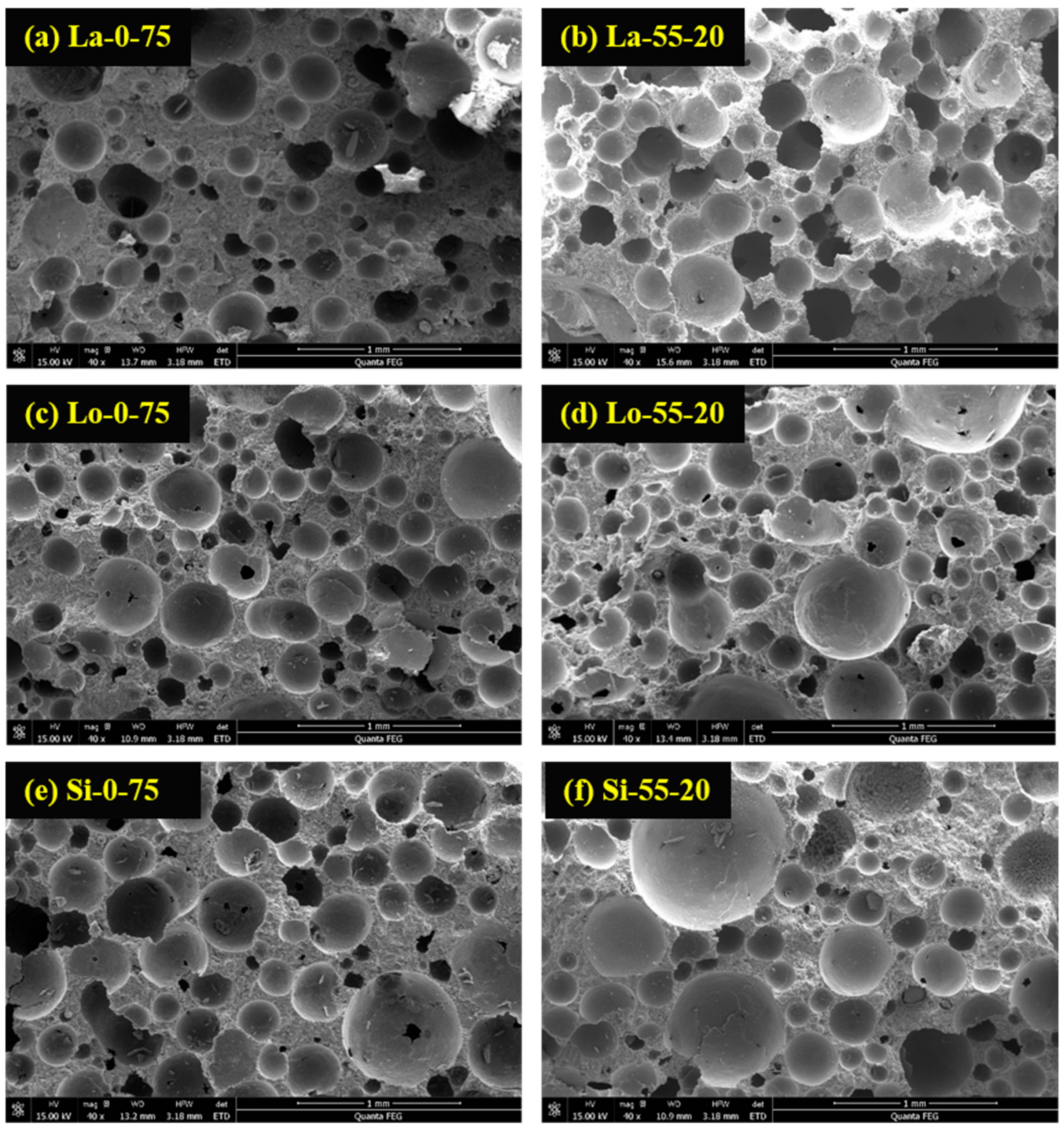


| Physical Properties | Measured Values | |
|---|---|---|
| Specific surface area (kg/m3) | 361 | |
| Normal consistency (%) | 28 | |
| Setting time (min) | Initial set | 223 296 |
| Final set | ||
| 3 days compressive strength (MPa) | 5.6 | |
| 3 days flexural strength (MPa) | 2.74 | |
| Material | SiO2 | Al2O3 | CaO | Fe2O3 | MgO | K2O | TiO2 | Na2O | Mn3O4 |
|---|---|---|---|---|---|---|---|---|---|
| PC | 21.61 | 6.13 | 58.19 | 4.00 | 0.84 | 0.99 | 0.33 | 0.13 | 3.94 |
| Laterite | 60.62 | 12.86 | 7.16 | 4.54 | 1.43 | 2.91 | 0.67 | 1.62 | 0.11 |
| Loess | 69.43 | 13.43 | 1.19 | 5.01 | 1.11 | 2.42 | 0.77 | 0.50 | 0.075 |
| Silt | 67.07 | 14.58 | 0.85 | 5.91 | 1.48 | 2.51 | 0.89 | 1.14 | 0.091 |
| SP | 32.24 | 15.38 | 40.11 | 0.36 | 8.98 | 0.52 | 0.55 | 0.44 | 0.22 |
| Code. | Type of Soil | Design Wet Density (kg/m3) | Soil (kg/m3) | SP (kg/m3) | PC (kg/m3) | Sodium Sulfate (kg/m3) | Water (kg/m3) | Foam (kg/m3) |
|---|---|---|---|---|---|---|---|---|
| La-0-75 | Laterite | 900 | 160 | 0 | 480 | 9.6 | 288 | 30 |
| La-35-40 | 900 | 160 | 224 | 256 | 9.6 | 288 | 25.6 | |
| La-45-30 | 900 | 160 | 288 | 192 | 9.6 | 288 | 24.5 | |
| La-55-20 | 900 | 160 | 352 | 128 | 9.6 | 288 | 23.5 | |
| Lo-0-75 | Loess | 900 | 160 | 0 | 480 | 9.6 | 288 | 30 |
| Lo-35-40 | 900 | 160 | 224 | 256 | 9.6 | 288 | 30 | |
| Lo-45-30 | 900 | 160 | 288 | 192 | 9.6 | 288 | 28.8 | |
| Lo-55-20 | 900 | 160 | 352 | 128 | 9.6 | 288 | 27.7 | |
| Si-0-75 | Silt | 900 | 160 | 0 | 480 | 9.6 | 288 | 30 |
| Si-35-40 | 900 | 160 | 224 | 256 | 9.6 | 288 | 24.5 | |
| Si-45-30 | 900 | 160 | 288 | 192 | 9.6 | 288 | 23.5 | |
| Si-55-20 | 900 | 160 | 352 | 128 | 9.6 | 288 | 22.4 |
| Code | 28 d Compressive Strength (MPa) | Compressive Strength after 5 Dry–Wet Cycles (MPa) | Water Stability Coefficient |
|---|---|---|---|
| La-0-75 | 4.32 | 3.66 | 0.847 |
| La-35-40 | 3.20 | 2.53 | 0.806 |
| La-45-30 | 2.32 | 1.85 | 0.797 |
| La-55-20 | 1.88 | 1.43 | 0.761 |
| Lo-0-75 | 4.25 | 3.72 | 0.875 |
| Lo-35-40 | 3.18 | 2.64 | 0.830 |
| Lo-45-30 | 2.21 | 1.76 | 0.796 |
| Lo-55-20 | 1.62 | 1.22 | 0.753 |
| Si-0-75 | 4.18 | 3.72 | 0.890 |
| Si-35-40 | 3.17 | 2.75 | 0.868 |
| Si-45-30 | 2.13 | 1.71 | 0.803 |
| Si-55-20 | 1.54 | 1.18 |
| Code | Average Diameter (μm) | Porosity (%) |
|---|---|---|
| La-0-75 | 160.47 | 0.39 |
| La-35-40 | 172.11 | 0.42 |
| La-45-30 | 173.50 | 0.44 |
| La-55-20 | 182.56 | 0.48 |
| Lo-0-75 | 167.39 | 0.41 |
| Lo-35-40 | 169.48 | 0.45 |
| Lo-45-30 | 173.13 | 0.52 |
| Lo-55-20 | 186.22 | 0.54 |
| Si-0-75 | 163.52 | 0.44 |
| Si-35-40 | 168.46 | 0.46 |
| Si-45-30 | 173.62 | 0.49 |
| Si-55-20 | 183.45 | 0.54 |
Publisher’s Note: MDPI stays neutral with regard to jurisdictional claims in published maps and institutional affiliations. |
© 2022 by the authors. Licensee MDPI, Basel, Switzerland. This article is an open access article distributed under the terms and conditions of the Creative Commons Attribution (CC BY) license (https://creativecommons.org/licenses/by/4.0/).
Share and Cite
Yang, X.; Xu, S.; Zhao, Z.; Lv, Y. Strength, Durability, and Microstructure of Foamed Concrete Prepared Using Special Soil and Slag. Sustainability 2022, 14, 14952. https://doi.org/10.3390/su142214952
Yang X, Xu S, Zhao Z, Lv Y. Strength, Durability, and Microstructure of Foamed Concrete Prepared Using Special Soil and Slag. Sustainability. 2022; 14(22):14952. https://doi.org/10.3390/su142214952
Chicago/Turabian StyleYang, Xinkui, Shi Xu, Zenggang Zhao, and Yang Lv. 2022. "Strength, Durability, and Microstructure of Foamed Concrete Prepared Using Special Soil and Slag" Sustainability 14, no. 22: 14952. https://doi.org/10.3390/su142214952






